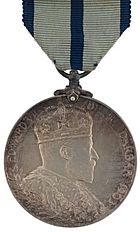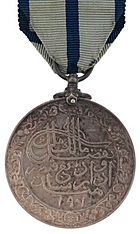Delhi Durbar Medal (1903) facts for kids
Quick facts for kids Delhi Durbar Medal, 1903 |
|
|---|---|
 
Obverse and reverse of 1903 Durbar Medal
|
|
| Presented by | United Kingdom and British Raj |
The Delhi Durbar Medals were special awards created by the United Kingdom and the British Raj (British rule in India). They were made to remember a big event called the Delhi Durbar. This was a grand ceremony where a new Emperor of India was officially announced.
There were two main Delhi Durbar Medals. One was made in 1903 for Edward VII, and another in 1911 for George V. Both medals were about 1.5 inches wide and came in two types: gold and silver. People wore them on the left side of their chest, hanging from a ribbon. These medals were a way to honor those who took part in the important Durbar ceremonies or helped the British Empire in India.
Contents
What was the 1903 Delhi Durbar Medal like?
The 1903 Delhi Durbar Medal had two sides, like a coin.
The Front (Obverse) of the Medal
The front of the medal showed a picture of King Edward VII. He was wearing a crown and a fancy robe made of ermine (a type of fur). He also had a special collar and badge from important royal orders. Below his picture, there was a laurel branch, which is a symbol of victory. Around the edge of the medal, it said: "EDWARD VII DELHI DURBAR 1903".
The Back (Reverse) of the Medal
The back of the medal had a beautiful design of roses. Inside this design, there was a message written in Persian. This message meant: "By the Favour of the Lord of the Realm Edward, King, Emperor of India, 1901". The medals were given out without any names engraved on them.
Who received the 1903 Medal?
A total of 140 gold medals were given out. These were usually awarded to important ruling chiefs in India. Another 2,567 silver medals were given to other important people. This included government officials and members of the armed forces who were part of the big celebrations.
Images for kids
See also



